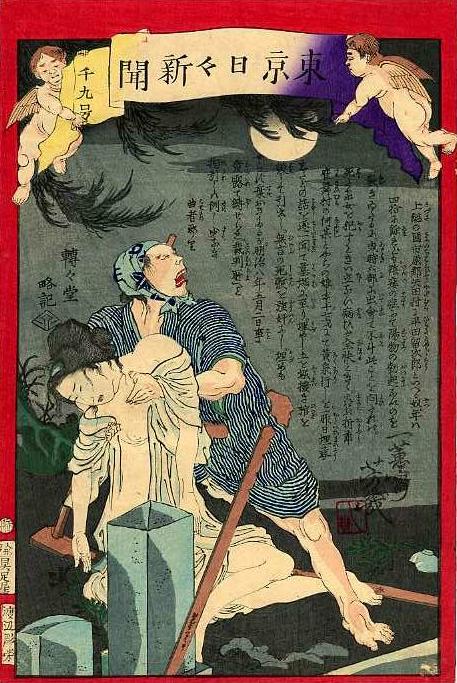Commentary
The newspaper version is much longer, more detailed, and more graphic. But many of the phrases in the nishikie version were adapted directly from the newspaper version (see Tsuchiya 2000, Bunsei Shoin CD-ROM).
Kadzusa (上総 かづさ), today "Kazusa" (かずさ), was a reduction of an earlier "Kami-tsu-fusa" in which "tsu" is a genitive like "no". Its counterpart is Shimōsa (下総) or Shimofusa, from Shimo-tsu-fusa.
The print reads "Yadamura" (矢田村) but the name of the village may was probably Yata. The print also reads "Ichiharagauri" (市原郡) thus also voicing the word for county (群 kauri &ng; kōri).
Yata and Tsurumai village (鶴舞村), which appears later in the story, were neighboring hamlets now parts of present-day Ichihara city in central Chiba prefecture. In 1889, Tsurumai absored Yata and four other villages, becoming a larger Tsurumai village in Ichihara county (郡 gun), and in 1891 Tsurumai became a town (町 machi). In 1954, however, Tsurumai disappeared as an entity when it was merged with another town and three villages to form a new town called Minamifusa (南総町), which in 1967 was incorporated with a village into Ichihara city (市原市).
sickness of pubic limpness reflects 陰痿の症 read "in'i no shiyau > shau > shō)", while not-standing malady represents 立ない病ひ (tatanai yamahi > yamai". The graphs of the first expression are marked with Sino-Japanese readings, while those of the latter are marked to be read in Japanese. Such paraphrasing is typical in stories written with an eye and ear for variation.
male thing reflects the graphs 陽物, which would be read "yōbutsu" in Sino-Japanese and mean "positive thing" hence "male organ". Here, though, the graphs are marked to read ゑてもの (wetemono), the contemporary kana orthography for "etemono" (得手物) or "that thing" -- "ete" being an oblique reference to something one does not wish to name.
did not stand up reflects 勃起ない, marked to be read "otsutatanai > ottatanai". The negative of the verb "tatsu" meaning "stand" is intensified by "otsu" hence "ottatsu" (おっ立つ), thus "vigorously stand" or "spring up". The graphs 勃起, as a Sino-Japanese expression, would read "bokki" and mean "erection".
pilgrim is graphed 六部 (rokubu), an abbreviation of 六十六部 (rokujōroku bu), a pilgrimage on which one visits 66 temples and shrines in various provinces -- in this case, a person who is making such rounds.
violate reflects 犯す (okasu), the object of which is a woman who is dead (死たる女 shinitaru me). It is differentiated from rape, which later in the story reflects 強奸 (がういん) -- though the reading is odd because the graphs, ordinarily read "g&###;kan", are marked to be read "gauin" (gōin), which is usually written 強淫 (gōin) -- literally "forced wantonness" or the like. Today "gōkan" is usually 強姦 (gōkan), which appears in other stories, such as TNS-824 Beautiful robber-rapist.
heals is written 全快 (なほる), which as a graphic Sino-Japanese expression read "zenkai" would mean "total recovery" but here is read as the verb "naoru" meaning "heal" or "be cured".
went to the Yellow Springs reflects the meaning of the graphs 黄泉行 as a Sino-Japanese expression. Phonetically the graphs are marked to read 黄泉行 (なくなり) し or "nakunarishi", the past tense of "nakunaru", literally "become not" hence "pass away" or "die". Yellow Springs was a Chinese metaphor for the nether world underground, among the springs of the yellow earth.
Schreiber version
Here is Mark Schreiber's somewhat freer and interpretive version as first posted for this story.
|
A man in his 40s named Hirata Tamejiro from Yada village in Ichihara-kori, Kazusa province [part of present-day Chiba prefecture] suffered from impotence. While embarking on a pilgrimage he happened to hear that to have intercourse with a dead woman would cure him of his malady. He subsequently learned that an unnamed 17-year-old woman in Tsurumai village had contracted a disease and gone to the netherworld. He found her grave site, excavated the coffin, broke it open, and proceeded to rape the unprotesting corpse, after which he discarded it. His act was discovered on 2 May 1875 and he was arrested and taken to court, where his perverted acts were revealed. |
